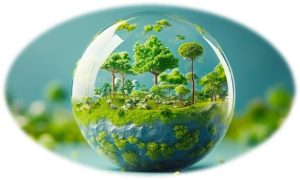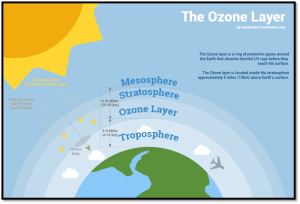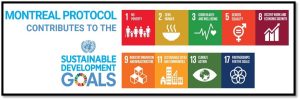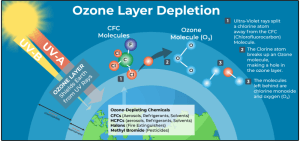Preservation of the Ozone Layer:
A Global Effort to Protect Our Planet
By Alyssa Jairam

Image Source: The Hans India
The world unites every year on 16th September to celebrate International Day for the Preservation of the Ozone Layer. This day marks the anniversary of the signing of the Montreal Protocol in 1987 on Substances that Deplete the Ozone Layer which has led to significant environmental progress. The Montreal Protocol is one of the most successful environmental international treaties to date with 198 countries committing to phase out the production and consumption of Ozone-Depleting Substances (ODS).
The Role of the Ozone Layer
The ozone layer is a fragile shield of gas located approximately 10 to 30 kilometers above the Earth’s surface in the Stratosphere. The ozone layer plays a crucial role in protecting life on Earth by absorbing the majority of the sun’s harmful ultraviolet (UV) radiation. Without this protective layer, humans would be at a significantly higher risk of developing skin cancer, cataracts and other health issues. Moreover, increased UV radiation damages ecosystems, reduces agricultural productivity and negatively impacts marine life.

Figure 1: Location of the Ozone Layer | Source: Action News 5
The Success of the Montreal Protocol
Since the implementation of the Montreal Protocol, the world has made remarkable progress in reducing the emissions of Ozone-Depleting Substances (ODS). According to the United Nations Environment Programme (UNEP), the protocol has led to a 98% reduction in the production and consumption of controlled ODS globally (UNEP, 2023). This reduction has been instrumental in the ongoing recovery of the ozone layer.
The protocol’s success is also reflected in public health benefits. The World Health Organization (WHO) estimates that the Montreal Protocol will prevent over 2 million cases of skin cancer annually by 2030, as the ozone layer continues to recover (WHO, 2023). In addition, the reduction of ODS has a positive impact on climate change since many ODS are potent greenhouse gases and their phase-out/reduction has prevented approximately 135 billion tons of CO2 emissions over the period 1990 to 2010 (UNEP, 2023).

Figure 2: The Montreal Protocol and its link to achieving SDGs. | Source: United Nations Environment Programme
Ongoing Challenges and Future Goals
While the Montreal Protocol has been successful, challenges remain. The illegal trade of ODS still poses a threat and new chemicals that could harm the ozone layer are under scrutiny. Additionally, the full recovery of the ozone layer is not expected until the middle of this century, making continued vigilance and international cooperation essential.
The Kigali Amendment to the Montreal Protocol, which was adopted in 2016, aims to phase-down hydrofluorocarbons (HFCs), a group of chemicals that are not harmful to the ozone layer but are powerful greenhouse gases. This amendment is expected to avoid up to 0.4°C of global warming by the end of the century (UNEP, 2023) and represents a critical step in addressing both ozone depletion and climate change.

Figure 3: Ozone Layer Depletion from Ozone-Depleting Chemicals. | Source: Prepp
How Can You Protect the Ozone Layer?
- Use public transportation or carpool and walk or ride a bicycle for short distances.
- Checks labels to ensure that aerosols such as air fresheners, hairsprays etc are free from CFCs.
- Ensure proper disposal of old refrigerators, air conditioners and other appliances containing ODS to prevent the release of these harmful substances.
- Use non-aerosol cleaning products and air fresheners.
- Conduct regular maintenance checks on your air conditioners and refrigeration units to prevent or repair leaks in your appliances.
- Conserve energy by turning off lights, appliances and electronics when not in use as this practice consumes less electricity thereby reducing the combustion of fossil fuels for electricity generation.
- Use energy efficient appliances such as LED bulbs, Energy Star air conditioners, refrigerators, fans etc.
- Share your knowledge by educating others on the importance and steps to protect the ozone layer.
Conclusion
International Day for the Preservation of the Ozone Layer therefore serves as a reminder of the power of collective action and the importance of safeguarding our environment. The progress made under the Montreal Protocol is a testament to what can be achieved when nations come together for a common cause. Hence, continued commitment to protecting the ozone layer and addressing new environmental challenges are crucial for ensuring a sustainable future for all.
“Ozone is like the Earth’s sunscreen. Just like we protect our skin from harmful UV rays, we must protect the ozone layer from damage.”
Want to learn more about how Kenson Group is promoting a greener environment? Discover some of the key activities through our Carbon Net Zero Capability Portfolio here: https://bit.ly/3v5K9pk
